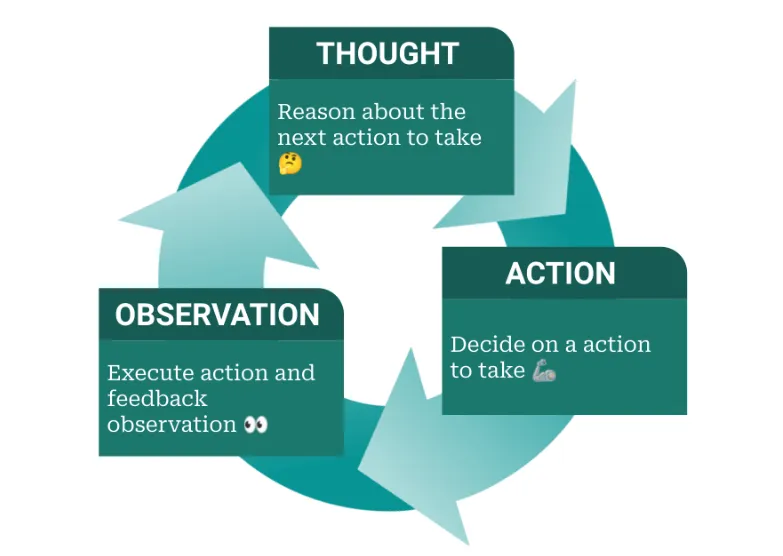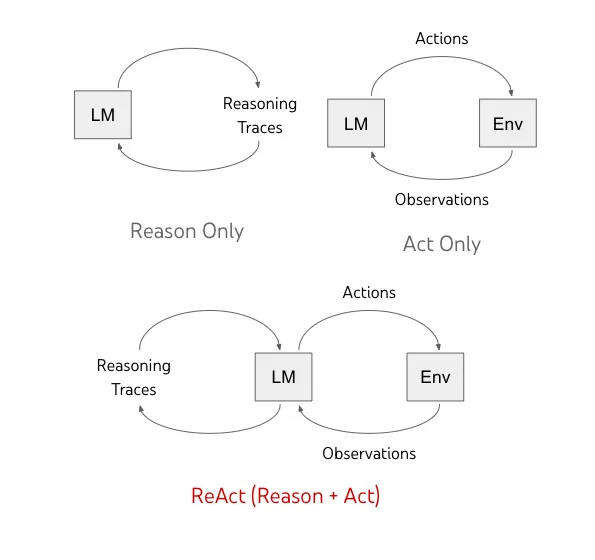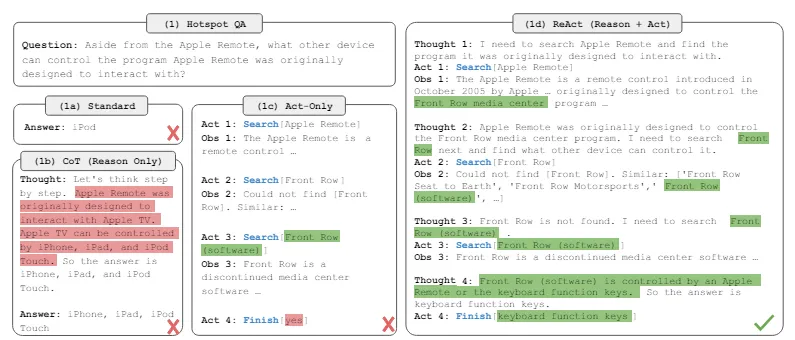Artificial Intelligence (AI) has evolved significantly over the years, with advancements in language models playing a crucial role. One of the latest innovations in this field is ReAct, a framework that synergizes reasoning and acting capabilities within large language models (LLMs). This blog explores the ReAct framework and its integration with Retrieval-Augmented Generation (RAG), highlighting how this combination enhances task performance and decision-making.
Understanding ReAct
ReAct, short for “Reasoning and Acting,” is a groundbreaking approach that combines reasoning traces and task-specific actions within LLMs. This integration allows the model to perform dynamic and context-aware decision-making, bridging the gap between reasoning and acting, which were traditionally studied as separate topics.

Core Components of ReAct
- Reasoning Traces: These are intermediate thought processes generated by the model. They help in breaking down complex tasks into manageable steps and maintaining a clear line of reasoning.
- Task-Specific Actions: These actions involve interactions with external environments, such as querying a database or accessing a knowledge base, to gather additional information needed for decision-making.
How ReAct Works
The ReAct framework prompts LLMs to generate both reasoning traces and actions in an interleaved manner. This method provides a structured way for the model to reason about the task, plan actions, and adjust its approach based on the feedback received from the environment.

Example Workflow: Cooking a Recipe
Consider the task of cooking a recipe. A human chef might:
- Reason: “Now that I have all the ingredients, I need to chop the vegetables.”
- Act: Chop the vegetables.
- Reason: “I don’t have salt, so I’ll use soy sauce as a substitute.”
- Act: Add soy sauce to the pan.
Similarly, in ReAct:
- The model generates reasoning traces to decide the next steps.
- It performs actions to gather necessary information or execute tasks.
- This process continues iteratively, allowing the model to adapt and refine its approach dynamically.
Advantages of ReAct
- Enhanced Task Performance: By combining reasoning and acting, ReAct allows the model to develop, maintain, and adjust high-level action plans, improving performance on complex tasks.
- Improved Interpretability: The reasoning traces provide insight into the model’s thought process, making it easier for humans to understand and trust its decisions.
- Error Mitigation: ReAct reduces issues like hallucinations (where the model generates incorrect or nonsensical information) by grounding its reasoning in data from external sources.
Applications of ReAct
ReAct has been tested across various tasks, demonstrating its versatility and effectiveness:
- Question Answering (HotPotQA): ReAct interacts with a Wikipedia API to retrieve relevant information, providing accurate and grounded answers. For example, when asked about historical events, ReAct can search Wikipedia, extract pertinent details, and synthesize a coherent response.
- Fact Verification (FEVER): In verifying claims, ReAct uses a similar approach by checking the claims against a Wikipedia database. This ensures that the information is accurate and up-to-date. For instance, if asked to verify a statement about a scientific fact, ReAct retrieves and cross-references multiple sources from Wikipedia to confirm the claim.
- Interactive Decision-Making (ALFWorld and WebShop): These environments require complex interactions over extended periods. ReAct significantly improves success rates by dynamically adjusting actions based on reasoning traces. In ALFWorld, ReAct navigates a virtual household to complete tasks, using reasoning to decide which rooms to explore and actions to take. In WebShop, it navigates an online shopping environment to find products matching specific criteria, reasoning through product descriptions and user requirements.
Real-World Applications of ReAct: Enhancing Decision-Making Across Industries
Healthcare Use Case: Diagnosing a Patient and Suggesting Treatment
Task: Diagnose a patient based on their symptoms and medical history, then suggest an appropriate treatment.
Reasoning Trace: “I need to collect the patient’s symptoms and medical history.”
Action:
Collect patient data through an electronic health record (EHR) system.
Observation: The patient reports symptoms of chest pain, shortness of breath, and fatigue. The medical history indicates hypertension and high cholesterol.
Reasoning Trace: “These symptoms could indicate a cardiovascular issue. I should check for possible conditions like angina or myocardial infarction.”
Action: Search the medical database for conditions matching the symptoms and medical history.
Observation: The symptoms and history match those of angina.
Reasoning Trace: “Next, I need to determine the appropriate treatment for angina.”
Action: Search the treatment guidelines for angina.
Observation: Treatment guidelines recommend medications like nitroglycerin and lifestyle changes, including diet and exercise.
Reasoning Trace: “The recommended treatment for the patient is nitroglycerin and lifestyle modifications.”
Outcome: The system suggests prescribing nitroglycerin and advising the patient on lifestyle changes to manage angina.
Banking Sector Use Case: Detecting Fraudulent Transactions
Task: Identify and flag a potentially fraudulent transaction on a customer’s account.
Reasoning Trace: “I need to review recent transactions for unusual activity.”
Action:
Retrieve the customer’s recent transaction history.
Observation: A transaction for a large amount of money was made from a foreign location that the customer has never visited.
Reasoning Trace: “This transaction appears unusual based on the customer’s history. I need to analyze it further for potential fraud.”
Action: Cross-reference the transaction with known fraud patterns and check for similar incidents.
Observation: The transaction matches patterns of known fraud, including the location and amount.
Reasoning Trace: “I need to flag this transaction as potentially fraudulent and alert the customer.”
Action: Flag the transaction and send an alert to the customer via email and SMS.
Observation: The customer confirms that they did not authorize the transaction.
Reasoning Trace: “The transaction is confirmed as fraudulent. I need to initiate a refund and further investigation.”
Action: Initiate a refund process and notify the fraud investigation team.
Outcome: The system flags the transaction as fraudulent, alerts the customer, initiates a refund, and notifies the investigation team for further action.
Combining ReAct with RAG
Retrieval-Augmented Generation (RAG) involves using external knowledge sources to enhance the generation process of language models. Integrating ReAct with RAG offers several benefits:
- Access to Up-to-Date Information: By querying external sources like Wikipedia, ReAct ensures the model’s knowledge is current and accurate. For example, when asked about recent events, ReAct can retrieve the latest information and incorporate it into its response.
- Context-Aware Decision Making: RAG provides the necessary context for ReAct’s reasoning traces, making the decision-making process more robust and informed. This is particularly useful in scenarios requiring extensive background knowledge, such as legal case analysis or medical diagnostics.
Comparing Different QA Approaches: Standard, CoT, Act-Only, and ReACT

Detailed Example: Solving a Complex Query
Let’s walk through a detailed example of ReAct in action:
Task: Determine the hotel where a specific Cirque du Soleil show is performed and find the number of rooms in that hotel.
- Reasoning Trace: “I need to search for the Cirque du Soleil show ‘Mystère’ to find the hotel where it is performed.”
- Action: Search Wikipedia for “Cirque du Soleil show Mystère.”
- Observation: Mystère is performed at the Treasure Island Hotel and Casino.
- Reasoning Trace: “Now, I need to find the number of rooms in the Treasure Island Hotel and Casino.”
- Action: Search Wikipedia for “Treasure Island Hotel and Casino.”
- Observation: The hotel has 2,884 rooms.
- Reasoning Trace: “The answer is that the Treasure Island Hotel and Casino has 2,884 rooms.”
By interleaving reasoning and acting, ReAct efficiently retrieves and synthesises the necessary information to solve the query.
Let walk through the code part
Utilizing ReAct Model for Analyzing NVIDIA’s Quarterly Report
We delve into how we can leverage the ReACT (Reasoning and Action) model to analyse complex financial documents, using NVIDIA’s latest quarterly report as an example. The ReACT model, enhanced by LlamaIndex, allows for comprehensive and nuanced understanding by connecting various pieces of information within the document.
To download the pdf
Collab Link ReAct_code
Setting Up the Environment
!pip install llama-index-llms-openai
!pip install llama-index-readers-file
!pip install llama-index-embeddings-openai
Importing necessary package
from llama_index.core import (
SimpleDirectoryReader,
VectorStoreIndex,
StorageContext,
load_index_from_storage,
)
from llama_index.core.tools import QueryEngineTool, ToolMetadata
from llama_index.embeddings.openai import OpenAIEmbedding
from llama_index.core import Settings
from llama_index.llms.openai import OpenAI
import os
import openai
from llama_index.core.agent.legacy.react.base import ReActAgent
Build Query Engine Tools
Initialize Storage Context
Try:
storage_context = StorageContext.from_defaults(
persist_dir="./storage/NVIDA"
)
nvida_index = load_index_from_storage(storage_context)
index_loaded = True
except:
index_loaded = False
Set Embedding Model
# global
Settings.embed_model = OpenAIEmbedding(api_key="api_key")
Load Data and Build Index (if not already loaded)
if not index_loaded:
# load data
nvida_docs = SimpleDirectoryReader(
input_files=[pdf_file]
).load_data()
# build index
nvida_index= VectorStoreIndex.from_documents(nvida_docs)
# persist index
nvida_index.storage_context.persist(persist_dir="./storage/NVIDA")
Configure OpenAI API
os.environ["OPENAI_API_KEY"] = "api_key"
openai.api_key = os.environ["OPENAI_API_KEY"]
llm = OpenAI(temperature=0, model="gpt-4-turbo")
Create Query Engine
nvida_engine=nvida_index.as_query_engine(similarity_top_k=3)
Define Query Engine Tools
query_engine_tools =
[
QueryEngineTool
(
query_engine=nvida_engine,
metadata = ToolMetadata
(
name = "nvida",
description =
(
"provides information about The document is a quarterly report (Form 10-Q)
from NVIDIA Corporation for the period ending April 30, 2023. It includes
financial statements, management's discussion and analysis, legal proceedings,
risk factors, and other information required by the Securities and Exchange Commission (SEC)"
"Use a detailed plain text question as input to the tool."
),
),
),
]
Setup ReAct Agent
The ReActAgent is called and passed the LLM, query engine tool, and content to process.
context = """
You are an expert on financial statement or quarterly report (Form 10-Q) analysis
"""
agent = ReActAgent.from_tools(
query_engine_tools,
llm=llm,
verbose=True,
context=context
)
Run Queries
response = agent.chat(
"How do the legal proceedings and risk factors mentioned in NVIDIA's 10-Q report potentially
affect their financial stability and market performance?"
)
print(str(response))
Response:
Thought: The current language of the user is English. I need to use a tool to help me answer the question.
Action: nvida
Action Input: {‘input’: “How do the legal proceedings and risk factors mentioned in NVIDIA’s 10-Q report potentially affect their financial stability and market performance?”}
Observation: The legal proceedings and risk factors mentioned in NVIDIA’s 10-Q report could potentially impact their financial stability and market performance by introducing uncertainties and risks. Legal proceedings, such as the derivative lawsuits against certain officers and directors, could lead to financial liabilities, reputational damage, and legal costs, affecting their financial position. Additionally, the risk factors related to evolving industry needs, technological changes, and competitive products could impact NVIDIA’s ability to meet market demands, develop new products, and maintain customer satisfaction, potentially affecting their financial results and market competitiveness.
Thought: I can answer without using any more tools. I’ll use the user’s language to answer.
Answer: The legal proceedings and risk factors outlined in NVIDIA’s 10-Q report could significantly impact their financial stability and market performance. Legal challenges, such as derivative lawsuits, may result in substantial financial liabilities, reputational harm, and increased legal expenses, which could weaken NVIDIA’s financial position. Furthermore, risk factors like rapidly changing industry requirements, technological advancements, and intense competition could hinder NVIDIA’s ability to adapt to market demands, innovate, and retain customer loyalty. These factors combined could adversely affect NVIDIA’s financial outcomes and its position in the competitive market.
Query:
"What are the key differences between the Compute & Networking segment and the Graphics
segment in terms of revenue and operating income for NVIDIA, and how do these differences
reflect the company's strategic focus areas?
Response:
The key differences between NVIDIA’s Compute & Networking segment and the Graphics segment in terms of revenue and operating income are significant and reflect the company’s strategic focus areas. The Compute & Networking segment, which includes AI and GPU platforms, has seen higher revenue due to increased demand from cloud service providers and consumer internet companies. This segment’s focus aligns with NVIDIA’s strategic emphasis on AI, generative models, and enterprise solutions. In contrast, the Graphics segment, which caters to gaming and professional visualization, experienced a decrease in both revenue and operating income, attributed to weaker gaming demand and lower shipments. This indicates that NVIDIA’s strategic priorities are currently more concentrated on expanding their capabilities and market share in areas related to Compute & Networking, rather than Graphics.
Query:
"How do NVIDIA's partnerships and cloud service offerings, such as NVIDIA AI cloud
services and collaborations with Google Cloud and ServiceNow, impact their revenue
and strategic positioning in the AI market?"
Response:
NVIDIA’s partnerships and cloud service offerings, such as NVIDIA AI cloud services and collaborations with Google Cloud and ServiceNow, significantly enhance their revenue and strategic positioning in the AI market. These collaborations enable NVIDIA to broaden its market reach and improve its offerings in the AI sector, providing cloud-based infrastructure and software solutions essential for training and deploying AI models. By partnering with leading cloud service providers and offering comprehensive software solutions, NVIDIA can serve a wider customer base and boost its revenue streams. Additionally, these partnerships enhance NVIDIA’s credibility and competitive edge in the AI market, establishing them as a key player in delivering cutting-edge AI solutions to enterprises.
Conclusion
The integration of reasoning and acting in ReACT represents a significant advancement in AI. By combining these capabilities within LLMs and leveraging RAG, ReACT enhances task performance, interpretability, and trustworthiness. This synergy not only improves decision-making and problem-solving but also opens new possibilities for applications in various industries, from customer service to healthcare.
In our analysis of NVIDIA’s quarterly report, the ReACT demonstrated its ability to effectively parse and interpret complex financial data. By iteratively reasoning through the document and performing targeted actions, ReACT was able to extract nuanced insights regarding NVIDIA’s revenue streams, legal proceedings, and financial strategies. This not only validated the robustness of the ReACT framework but also showcased its practical utility in real-world applications.
As AI continues to evolve, frameworks like ReACT will play a crucial role in developing intelligent systems that can seamlessly blend reasoning with action, ultimately leading to more effective and reliable AI solutions. The success of ReACT in handling detailed financial analysis exemplifies its potential to transform how we interact with and interpret large, intricate datasets across various sectors.
